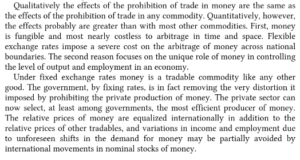Laffer defended fixed exchange rates and the gold standard against the challenges of Triffin, Friedman, and the bulk of the economics profession by 1970. Laffer maintained that fixed exchange rates conduced to a more perfect money supply globally. If the price of money was the same everywhere, quality would rise to the top. He said so in Madrid in 1970 at a conference whose proceedings were published three years later by Laffer’s Chicago colleague Harry Johnson.
Jude Wanniski once called Laffer’s view on this matter perhaps the hardest to comprehend in the supply-side tradition. If there is one price for money, there is acceptance of a public standard for what money should cost. Hence where there is one price for money—gold at a specified dollar price, say—it is a government, or perhaps more accurately a public system. Where there are various prices for money, it is a private system, in which each producer offers money for sale at different rates:
In the nineteenth century in the free-banking era, for example, there was a generally accepted or “public” notion of what the dollar was (just under an ounce of silver). Banks produced their own currency on that public definition and bid for takers on quality grounds. Laffer called this a government (or a public) system.
Accepting a public price of money led to quality arbitrage of the supply of money of an extremely valuable sort, to the economy at large. Laffer was warning the world, in 1970, not to dispense with fixed exchange rates and gold, because they led to enormous real-economic gains:

From Arthur B. Laffer, “Two Arguments for Fixed Rates,” in The Economics of Common Currencies, ed. Harry G. Johnson (Cambridge, Mass: Harvard University Press, 1973)

